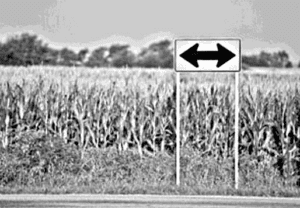Chapter 12 : Habitat Management Decisions
12.1 Introduction
12.2 Problem Statement, Goals, and Objectives
12.3 Alternative Actions That Focus on Objectives
12.4 Scoring the Utility of Alternative Actions
12.5 Example: Choosing Action for Dealing with Sediment
12.4 Introduction

Habitat management requires clearly identifying the habitat problem, goals for remediation, and objectives to attain the goals and choosing alternative management actions to reach the objectives. Decisions about habitat management are sometimes simple. Some problems have an obvious solution, and given the same objectives, two decision makers probably could choose similar alternative actions. More often, the scope and complexity of some of the habitat problems can make choosing difficult. Thus, decisions can be complex, and multiple decision makers easily can disagree on alternative actions (Figure 12.1). Furthermore, the process by which alternative actions are chosen can be difficult to explain, which in turn makes it hard to communicate to administrators, partners, stakeholders, and the public. A structured approach to choosing among alternative actions can facilitate and clarify the decision-making process by decomposing a problem into elements that are easier to rationalize and convey.
Decision science is being applied increasingly in management of natural resources (Conroy and Peterson 2013). This section describes a basic structured approach to arriving at decisions about implementing management to address perceived habitat problems. More complex models for arriving at optimal decisions are beyond the scope of this section but are available from Conroy and Peterson (2013).
The approach considered here includes three major components. First, identify goals and objectives to address the perceived problem. Second, recognize alternative actions to achieve the objectives. Third, score alternative actions relative to meaningful criteria that estimate the utility of each action. Once utilities are quantified, the manager can select one or more actions to address the habitat problem.
Back to the Top
12.2 Problem Statement, Goals, and Objectives
The first step is a problem statement that includes a clear declaration of the fish habitat problem and the underlying problem to be solved. This first step may be completed in-house by agency personnel but may require participation by key stakeholders (section 13), ensuring that collectively key stakeholders have a say and ultimately concur on the problem statement. This first step guides the process toward clearly stating the problem to be solved and ensures that ultimately the right objectives are established to solve the right problem. In many cases the problem is poorly stated, if stated at all. This can lead to actions that may not address the problem adequately, may waste time and resources, and even may create new problems and conflict with partners and stakeholders.
Defining the problem can be more complicated than it seems. This is often where managers may struggle because they react to what they think the problem is. Trying to better understand why one thinks there is a problem may help elucidate the problem more clearly. This search may include questions such as (1) what are we observing that causes us to think there is a problem; (2) where is the problem happening and how; (3) when and why is it happening; and (4) how are fish affected by the problem. Based on the answer to these or similar questions it would be appropriate to write down a paragraph starting with something such as, “The following should be happening, but isn't.” If the problem seems overwhelming, it may be necessary to break it down into several problems by repeating the process. If the problem consists of several related problems, it may be necessary to prioritize which problems should be addressed first.
A goal is the end that the manager wishes to achieve through the management action(s). Goals are broad-brush statements that identify the overall management purposes or a desired end state. For example, generic statements such as “maintain adequate habitat connectivity” or “improve water quality” are general statements (goals) about why management actions are undertaken. Habitat management goals should identify the desired state of the system once the identified problem is resolved. A goal itself does not have to include a measure or target necessarily but rather should provide a focus for steering toward a solution to the problem.
Objectives are more specific than goals and are ways of achieving the goals. There may be multiple objectives necessary to achieve a goal, and some objectives may include subobjectives. Whereas goals relate to the “big picture” or desired end result, objectives should be specific and measurable. An objective is not just a subgoal but provides a level of specificity necessary to implement broad-based goals fully. Structuring goals and objectives in a hierarchy can crystalize the nature of the problem and reveal any key objectives that may be missing or redundant.
Back to the Top
12.3 Alternative Actions That Focus on Objectives
Defining alternative actions involves identifying feasible management actions that have the potential to address the objectives. Various alternative actions are reviewed in earlier sections. However, managers should not be constrained by what has worked in the past; this is the time to be creative in crafting alternative actions. This is an exercise in which alternative actions are considered in terms of how well they might meet the objectives relative to various criteria. Some actions may work well to meet some criteria (e.g., feasibility criterion) but not meet other criteria (e.g., affordability criterion). Similarly, some actions may work well in some reservoirs to meet some objectives but not work at all in others; for many actions it may not be known how well they will work. Defining alternative actions may need to involve input from partners and stakeholders with a diverse expertise base.
Back to the Top
12.4 Scoring the Utility of Alternative Actions
Become a Contributing Sponsor
Become a part of projects that need your support.

